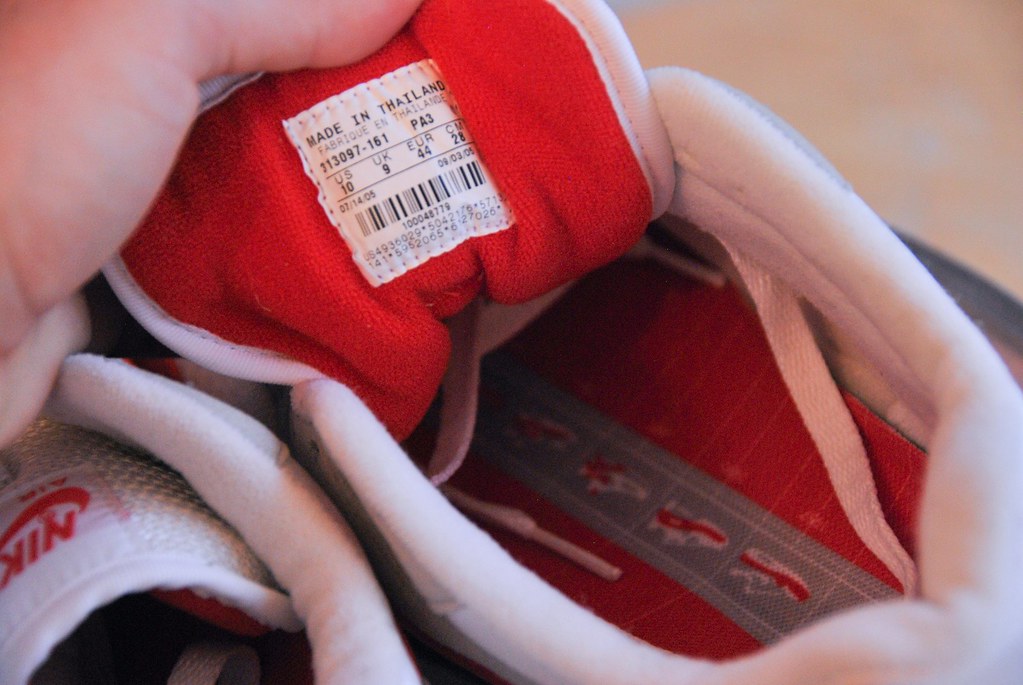When it comes to iconic brand names, few can rival the recognition and success of Nike. The American multinational corporation has been synonymous with athletic footwear and apparel since its founding in 1964.
But did you know that even something as seemingly insignificant as a tag can have a rich history? In this article, we’ll take a closer look at the evolution of the Nike tag, from its humble beginnings to the present day.
The Early Days

Nike’s first logo was designed by a graphic design student named Carolyn Davidson in 1971. It featured a swoosh, which has become one of the most recognizable logos in the world. However, it wasn’t until 1972 that Nike began using tags on their products nike tag history
Ever since the Nike tag first appeared on running shoes in 1971—designed by Carolyn Davidson, an undergraduate student at Portland State University who was hired by Phil Knight and Bill Bowerman to create it—it has become a recognizable symbol that stands for inspiration and innovation.
Little did anyone know back then just how much of an impact this simple graphic design would have when displayed prominently on Nike’s apparel and accessories: In one fell swoop, the swoosh-within-a rectangle became synonymous with modern sportswear and has been adopted as a sought after fashion statement among sneakerheads around the world. To learn more about this iconic logo’s history, read on!
Jumpman Era (1984-1988)
For the first time in athletic apparel history, we witnessed the culture and core fundamentals of Nike change dramatically due to the impact of Michael Jordan. Jordan, a 21-year-old at the time, signed a five-year endorsement deal worth $2.5 million, which was seen as a significant investment considering his yet-to-be-proven talent in professional basketball.
The introduction of the iconic Air Jordan 1 during this era revolutionized the sneaker industry, making it the most coveted shoe of the decade and continuing to hold its place as the greatest sneaker of all time.
Beyond the Air Jordan line, Nike apparel from this era featured a distinctive blue tag with a silver swoosh and script. The graphic designs during this period became bolder, more vibrant, and showcased designs such as the Air Force 1, Nike Dunks, and more, prominently featuring their prized signee—Michael Jordan.
MJ Takeover (1988 – 1993)
As the new decade began in the 1990s, Nike made significant changes to their brand’s appearance. In line with this, they decided to modify their tagline to match the revamped image. With Michael Jordan as the ultimate face of the brand, it seemed only fitting to change their base color from blue to red.
As a result, the iconic blue tags were replaced with a new red and gray tag. This simple gray tag not only symbolizes the shift in Nike’s branding but also takes us back to a nostalgic time when the Chicago Bulls dominated the NBA, winning three consecutive championship titles from 1991 to 1993.
As the late 90s approached, Nike underwent another transformation, adopting a black and red logo while maintaining red as their primary color. These changes reflect the evolution of Nike’s brand identity over the years, capturing the spirit of different eras in sports and pop culture.
Exploring the origins of Nike’s iconic Swoosh logo

One of the most recognizable logos in the world, the Nike Swoosh has become synonymous with athleticism and excellence. But have you ever wondered how this iconic symbol came to be? The story goes that in 1971, Nike co-founder Phil Knight asked graphic design student Carolyn Davidson to come up with a logo for their fledgling company.
Davidson eventually settled on the Swoosh, which she described as representing the wings of the Greek goddess of victory, Nike. Though Knight was initially hesitant about the design, he ultimately decided to move forward with it – a decision that would forever change the course of not just Nike, but the entire world of branding and advertising.
So the next time you spot that familiar Swoosh emblazoned on a pair of sneakers or an athletic jersey, take a moment to appreciate the creative vision and innovation that went into its creation.
Tracking the evolution of unique Nike tags over the decades

As lovers of sneakers, we know that the Nike swoosh is not only an iconic symbol but also a mark of quality. But have you ever paid attention to the tags attached to your Nike kicks? Tracking the evolution of these unique tags over the decades is not only fascinating, but it also tells the story of Nike’s growth and innovation.
From the early days of basic white tags to the current slew of detailed labels, each one has its own unique story to tell. So, the next time you unbox a fresh pair of Nikes, take a moment to appreciate the intricate history that comes with it. Or better yet, start building your collection and see how many different tags you can track down!
How Nike’s distinctive tags appeal to a young and diverse audience
When it comes to fashion, there’s nothing quite as recognizable as that iconic swoosh. But Nike’s distinctive tags go beyond just a logo. They’re a statement of style that resonates with a young, diverse audience.
With a brand that’s constantly pushing the envelope, it’s no surprise that their tags are just as innovative. Whether it’s a bold graphic or a subtle nod to classic design, each tag has a unique personality that speaks volumes about the person wearing it.
And that’s exactly what today’s youth are looking for – a way to express themselves and stand out from the crowd. Whether you’re hitting the gym or hanging out with friends, Nike’s tags are a must-have for anyone looking to make a statement.
Examining the changes in materials used for Nike tags

When it comes to the world of athletic apparel, every little detail matters – even the tag on the back of your shirt. And with a company as beloved and widely recognized as Nike, it’s no surprise that they’ve put plenty of thought into the materials and design of their tags over the years.
From the early days of plain paper tags to the more recent switch to recycled polyester, Nike is always looking for ways to innovate and improve. It’s not just about making their gear look sleek and modern; it’s about sustainability, durability, and creating a product that athletes can feel proud to wear.
So let’s dive into the fascinating world of Nike tag materials to see how this iconic company continues to push the envelope in the fashion and sports industries alike.
Unraveling the creative process behind designing Nike tags
Have you ever taken a closer look at the Nike tags on your favorite sneakers or workout clothes? Do you ever wonder about the creative process behind their design? The truth is, a lot of work and thought goes into the making of these seemingly small tags.
From choosing the right materials to determining the perfect size and shape, the Nike design team puts careful consideration into every detail. By understanding the needs and wants of their customers, they create tags that not only represent the brand but also add a unique touch to each individual product. So the next time you’re admiring your Nike gear, take a moment to appreciate the thoughtfulness that went into those little tags.
Exploring how Nike’s tag designs advertise their products

When it comes to advertising, Nike definitely knows how to make a statement. From their iconic swoosh symbol to the catchy taglines that accompany their products, every aspect of their branding is carefully crafted to leave a lasting impression on their customers.
But have you ever thought about the little tag that comes attached to their apparel? You know, the one that you usually just cut off without a second thought? Well, those tags are actually a critical component of Nike’s advertising strategy.
By incorporating bold typography, vibrant colors, and clever taglines, Nike’s tag designs are an ingenious way to promote their brand and products in a subtle yet effective way. So the next time you buy a pair of athletic shorts or a new pair of sneakers, take a closer look at that little tag – you might just be surprised by how much it advertises about Nike’s brand identity.
Analyzing the impact of digital technology on modern Nike tags
The world of sneakers has undergone a massive transformation over the years, and Nike has been at the forefront of this revolution. The introduction of digital technology has played a significant role in this transformation, particularly concerning how Nike tags are designed and utilized in the modern era.
The digital era has provided Nike with an opportunity to personalize its tags in ways that were once unimaginable. With features such as custom text and imagery, and the ability to create a unique design for each individual pair of sneakers, Nike has created a new level of customization that has taken the shoe game to another level.
This impact of digital technology on modern Nike tags has opened up a world of possibilities for sneakerheads and has allowed Nike to further cement its status as a leader in the industry.
How do I know if my Nike tag is vintage?

Determining the authenticity of vintage Nike clothing can be a bit challenging, but there are some key indicators to help you distinguish genuine items from counterfeit ones. Firstly, closely examine the quality of the material, stitching, and any prints or embroidery on the garment, as authentic Nike products will showcase a high level of craftsmanship and attention to detail.
Carefully inspect the tags for accurate information about sizing, care, and country of manufacture, and compare them with the examples provided in this guide to help determine the age and authenticity of your Nike item. Authentic Nike tags will have consistent font and logo designs that align with the brand’s history.
Furthermore, be cautious of Nike clothing with unusually low prices, as this could be an indicator of counterfeit goods. If you’re ever uncertain about an item’s authenticity, seek the advice of experts or purchase from well-established and reputable sources to ensure you are investing in genuine vintage Nike products. Remember to stay informed about the latest trends and developments in the vintage Nike market to make informed purchasing decisions.
How to tell if Nike is vintage from the tags?
The best place to start when it comes to identifying vintage Nike is the tags. Essentially every piece of Nike clothing will have a tag at the time of its manufacturing, and because Nike regularly updates the design of these tags, we can assess the design to work out which era a vintage Nike piece was made in.
It should be noted that due to the nature of global manufacturing all the timelines of when tags were used are estimates. Even Nike themselves would have a difficult time of pinning down an exact date of production based purely on tags.
However, other factors like specific label variants, stitching details, and logo changes can provide additional clues when trying to determine the age of a vintage Nike item. If you’re still struggling to figure it out, you can submit your tags here for us to have a look at and try to investigate further.
When did Nike use a blue tag?

The early days of Nike were marked by the use of the name “Blue Ribbon Sports”. They were still in their fledgling stage and didn’t have the iconic swoosh that we are so accustomed to seeing now. In those days, Nike was still taking baby steps, and the simple message of “Blue Ribbon Sports” was good enough for people to recognize the brand. During this time, they used a blue tag with a blue ribbon that was attached to the laces of their shoes. The style of the tag was simple, with just the company name and the iconic blue ribbon design.
The first change to Nike’s blue tag came in 1971. Blue Ribbon Sports changed its name to Nike Inc., and the blue ribbon design was replaced with the swoosh logo. This was a significant moment in Nike’s history and was the birth of the brand that we all know today. But this change also meant saying goodbye to the traditional “Blue Ribbon Sports” blue tag. Nike developed a new blue tag with the “Swoosh” and the word “Nike” written in bold.
The second change to Nike’s blue tag came in 1982. Nike introduced one of its most successful products ever, the Nike Air Force 1. With a new product, Nike introduced a new blue tag that included the word “Air.” The new tag included the newly designed Nike lettering above a light blue “Air” detail. This change in the tag was significant because it introduced the concept of using new tag colors to represent different product lines.
In 1991, Nike released another product that would change the landscape of athletic footwear: the famous Nike Air Jordan. With the release of this product, Nike once again introduced a new blue tag. The new tag was a combination of red and black, which matched the colorway of the Jordan sneakers. The new red and black tag also included the Nike Swoosh on one side, and the wings logo (representing the Air Jordan line) on the other.
Over the years, Nike has undergone several re-branding efforts that introduced new tag designs and colors. An example of such an effort was the “Nike Air” campaign from 2000 to 2003. During this era, Nike introduced a new tag with the letters “AIR” on one side and the word “Nike” on the other. The new tag color was light blue, and it was an instant hit among the sneakerheads.
What era is the Nike red tag?
The Nike red tag made its first appearance on Nike sneakers in the late 1970s, around 1978. This was during a time when Nike was still a relatively new company, having only been established in 1964. The original red tag was quite different from the design we know today, featuring a slightly different font and a shorter message. The first tags were also made of fabric rather than the plastic tags that are more common today.
In the 1980s, Nike redesigned the red tag to better suit their new range of sneakers. This new tag was made of plastic and featured a sleeker design with a bolder font. This redesign marked the beginning of the modern era of the Nike red tag. From this point on, the tag would be a constant feature on Nike sneakers, becoming as much a part of the design as the classic Nike swoosh.
Through the 1990s and into the early 2000s, Nike made a few small tweaks to the design of the red tag. These tweaks were mostly subtle changes to the font and spacing of the tag’s message. However, throughout this time, the tag remained largely unchanged. It became an integral part of the Nike brand, a symbol of quality and innovation that consumers associated with the company.
In recent years, Nike has returned to the original design of the red tag, bringing back the fabric tag that was used in the 1970s. It’s a nod to the company’s history and a way of celebrating the heritage of the Nike brand. However, they’ve also kept the plastic tag that is more common today, ensuring that the red tag continues to be a constant presence on their sneakers.
Do Nike tags say made in China?

For those who are unfamiliar with Nike, the brand began its journey as “Blue Ribbon Sports” in 1964. It was not until 1971 that the brand was officially renamed “Nike.” Since then, Nike has been one of the most popular brands around the globe, not just for their stylish designs and comfortable products, but also for their diverse manufacturing locations. The production locations of Nike products are spread out all over the world, with factories located in the United States, Vietnam, Indonesia, and China, to name a few.
While it is true that Nike does have manufacturing factories in China, not all of their products are made there. To ensure that only top-quality materials are used, Nike staff carefully select manufacturing factories based on the skills and abilities of the employees and their commitment to producing products of the highest quality. This means that Nike products can be made in any of their factory locations, depending on which factory is best suited for a specific product’s requirements.
However, it may still be surprising to find out that Nike typically designs their products in the United States, but many of those designs are subcontracted abroad for manufacturing. This is mainly in order to cut down the costs of manufacturing and ultimately lower the prices of the products for consumers. The majority of Nike products are made in Vietnam, followed closely by China, with Indonesia and Thailand coming in third and fourth place.
It’s worth noting that even though Nike products are made in China, the quality of the product is never compromised. Nike has established strict manufacturing guidelines that must be followed to ensure that their products meet their standards. Additionally, Nike monitors their factories and supply chain operations to ensure that workers are treated ethically and that the production process complies with labor laws and environmental standards.
Conclusion
As we can see, Nike’s tag designs have transformed significantly throughout the past few decades, no matter what materials they are made from or who the target audience is. From gooey paper tags to holographic technology, Nike has undoubtedly crafted iconic and creative tags that speak to their culture and advertise their products in new and innovative ways.
The impressive evolution of their Swoosh logo still stands out as an iconic marvel in the design community today. Going forward, it’ll be interesting to see what exciting new take Nike comes up with for their tags as digital technology continues to rapidly evolve in modern society – who knows what kind of advancements we’ll have seen by then?
With that being said, if you’re a creative type looking for inspiration for tag designs of your own, looking into Nike’s journey could be a great place to start.



